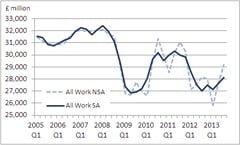In the last two quarters construction output in the UK has shown steady growth, rising by 1.7% in Q3 and 1.9% in Q2 after a prolonged period of predominantly negative growth which began in Q3 2011, according to figures released on 8 November by the Office for National Statistics.
There were conflicting stories in the sub-sectors in Q3, which saw new work show strong quarterly growth of 3.1%, the highest quarterly growth since Q2 2010, but a fall in repair and maintenance of 0.6%. The 1.7% growth in Q3 is the highest Q3 growth since 2003.
When comparing Q3 2013 with Q3 2012, construction output increased by 4.1%, predominantly due to a 6.2% increase in new work. Within the new work category, private new housing increased by 15.6% and private commercial other new work by 12.5%, while infrastructure fell by 3.7%. These three sectors accounted for approximately 75% of all new work, with a combined volume of £13.1billion of the estimated £17.4billion worth of output of new work in Q3.
Construction output shows quarterly year on year growth for two consecutive periods for the first time since Q2 2011, with the main contribution to this growth coming from the new housing work, which shows year on year growth of 14.1%.
Comparing September 2013 with the same month a year earlier, the output of construction increased by 5.8%. Over the same period, new housing showed growth of 13.6%.
Construction output fell by 0.9% in September when compared with August 2013 with all sectors, excluding public new work and private commercial other new work, estimated to have fallen month on month.
The Preliminary Estimate of Gross Domestic Product (GDP) published on 25 October contained a forecast for quarterly construction output of 2.5%. This estimate has been revised within this release based on updated survey responses and is now estimated to be 1.7%, a downward revision of 0.8 percentage points.
This downward revision is too small to have an effect on the preliminary estimate of GDP growth correct to one decimal place. Construction currently accounts for 6.3% of GDP.

